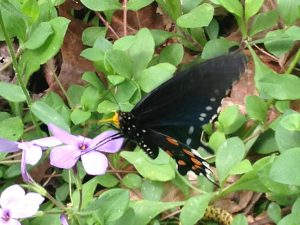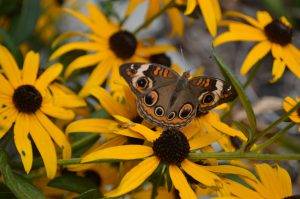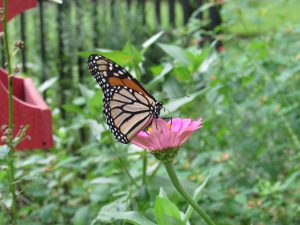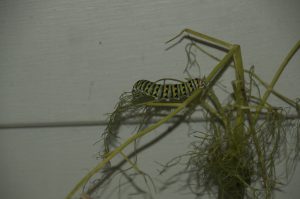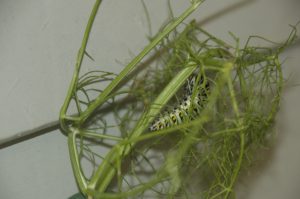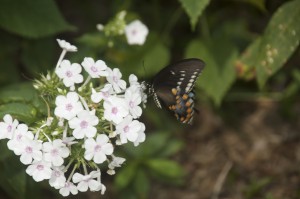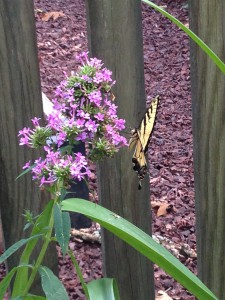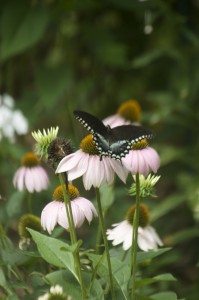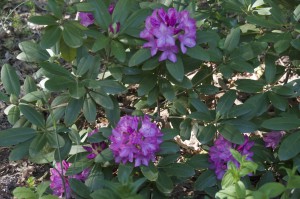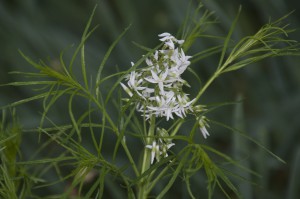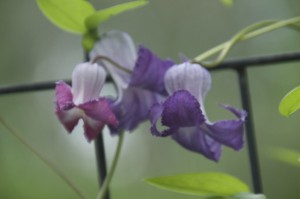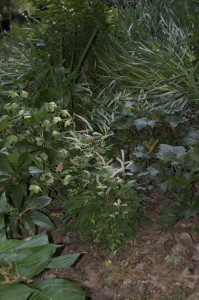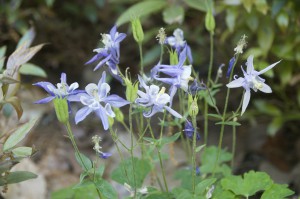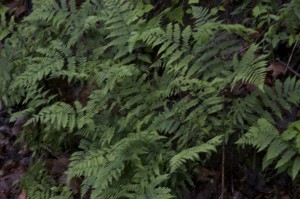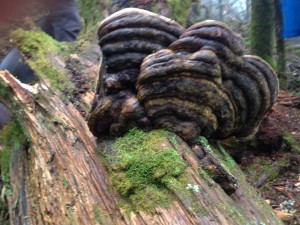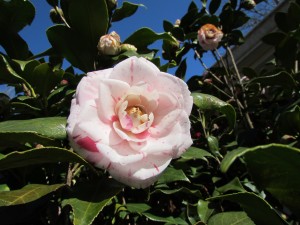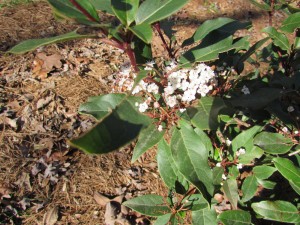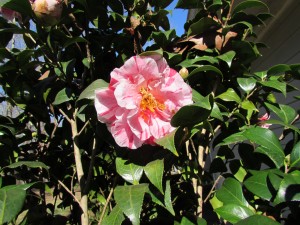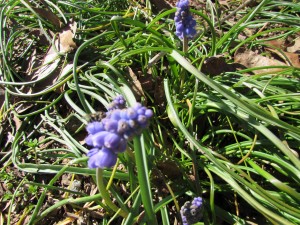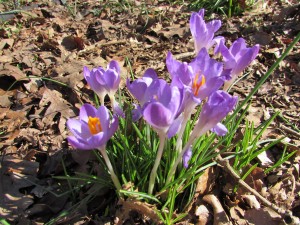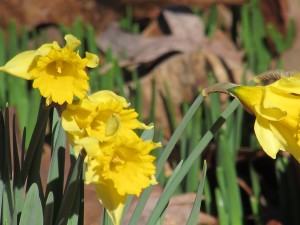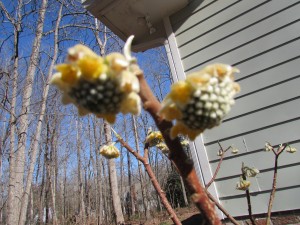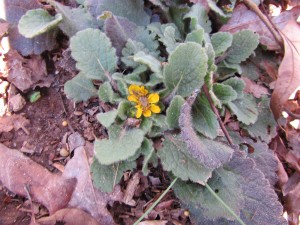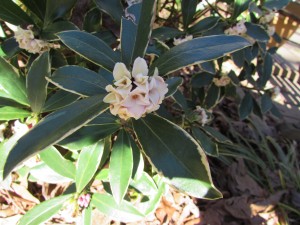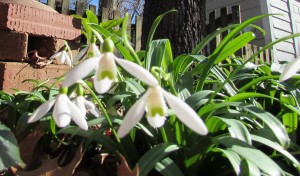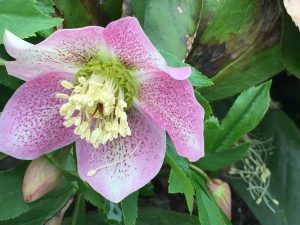
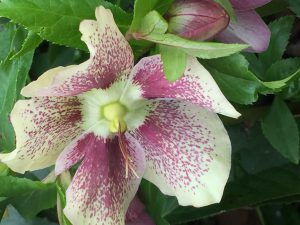
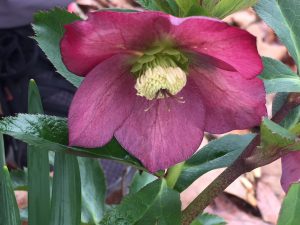
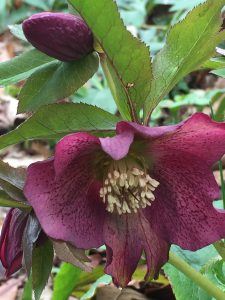
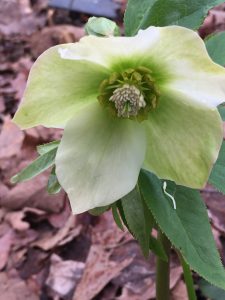
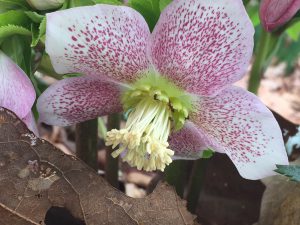
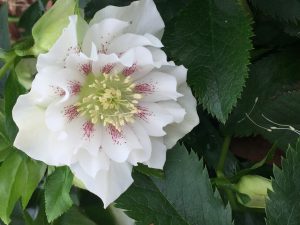
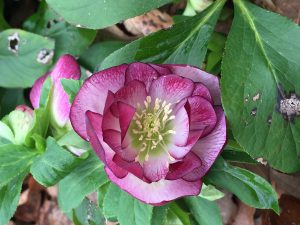
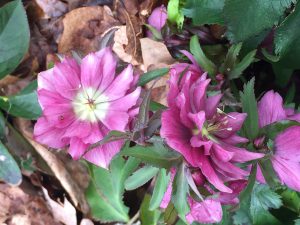
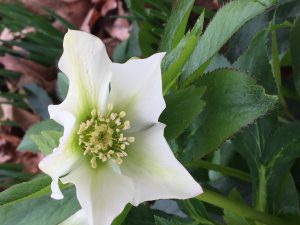
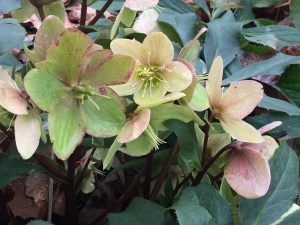 The many faces of hellefores in my gardens….I started out with three hellebores about 20 years ago, and now I have hundreds. Have probably given away as many as I still have. I haven’t bought more in years, but they do go to seed so they just spread themselves in the woods. Although they are not native, I still love them because I have blooms in February to put in the sanctuary at church, and plants to share with friends.
The many faces of hellefores in my gardens….I started out with three hellebores about 20 years ago, and now I have hundreds. Have probably given away as many as I still have. I haven’t bought more in years, but they do go to seed so they just spread themselves in the woods. Although they are not native, I still love them because I have blooms in February to put in the sanctuary at church, and plants to share with friends.
Category Archives: Uncategorized
Looking Out My Back Door
Here it is, already the second day of May. Where did the spring go? There were many pretty flowers blooming throughout the month of April, with many of them still blooming into May. This year I have added several dozen ferns to the beds, some more bleeding hearts, three patches of Blue Eyed Grass, and three new varieties of Milkweed. The Ironweed and Joe Pye Weed have starting peeking out of the ground. Liatris has its first buds, and some of the coneflowers are bully bloomed out. New plantings of Fairy Wand are blooming, along with the Fly Poison. It’s an adventure every day, just walking through the yard.
This is one of the three varieties of Amsonia in the pollinator garden. It will bloom for a couple of more weeks, then will make unusual long brown tubular shaped leaves that look like they are covered with felt.
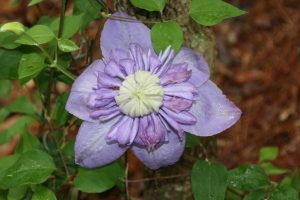
One of the non native clematis plants that is growing up a tree in the front yard. It is a double bloom.
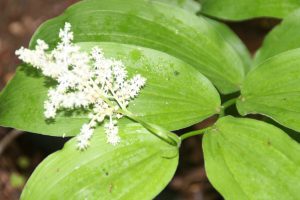
False Solomon’s Seal is one of the prettiest early spring blooming natives. The blooms have faded since this picture was taken, but it will develop some nice reddish berries later in the summer.
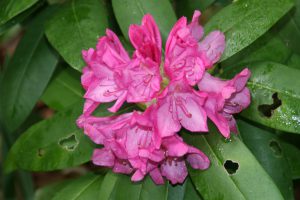
Two of the three rhododendrons in the front yard died this year, probably victims of the drought last summer. But this one has outdone itself with the blooms this spring.
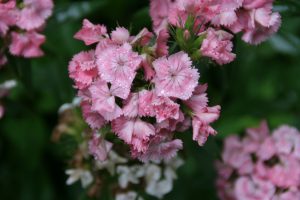
This is a pass along plant from Mama’s garden, which she got from her mother’s garden years ago. This is the true ‘Sweet William’, which has a wonderful smell which cannot be matched by the hybrids found in the stores today.
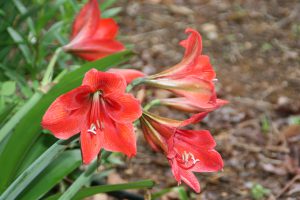
These amaryllis were given to me by a friend many years ago. They have multiplied and been shared many times.
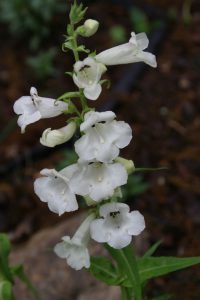
I’m not even sure what this plant is, but I sure do love white blooms. It is a good reliable bloomer all spring.
Memories of Fall, Faces of Spring
Today was a glorious day outside, and I suddenly realized that I haven’t taken any pictures of the spring garden. As I walked around, it hit me that the first daffodils have started to fade and the next round aren’t ready to bloom yet. So if i wanted to share some pictures, it had to happen soon.
While I was taking pictures of the spring blooms, the remnants of fall were still all around-the dried flower heads the seeds pods seemed like ghostly reminders of the winter just past. So here are some pictures of the memories of fall.
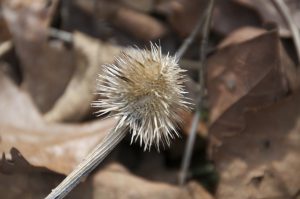
Purple coneflower seed pod. The seeds are all gone, either picked and planted or eaten by the birds. I think back to the beautiful butterflies who hovered over the blossoms sipping nectar. Because of them, the coneflowers produced seeds, assuring I would have more plants for the coming summer. I just love the way nature takes care of things.
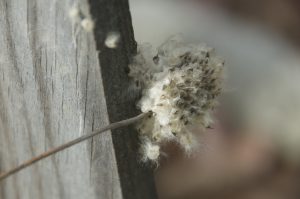
Tall thimbleweed is such a pretty flower when it’s in bloom. This is the seed head of the thimbleweed. Each seed is surrounded by what looks and feels just like cotton. They will sometimes be blown about by the wind, but mostly are carried by birds who eat the seeds and then poop them out to scatter the flowers. I collect many of the seeds to propagate in my basement.
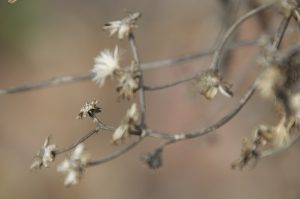
Ageratum plants are a late summer must-have to feed the butterflies and bees when most everything else has started to shut down. Its pretty lavender fuzzy blooms create these seeds which have a feathery attachment, allowing the seeds to float on the wind.
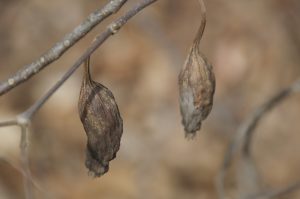
These sweet shrub seed pods like like some kind of overwintering insect in a cocoon. I like to leave them on the shrub because I just think they are neat looking.
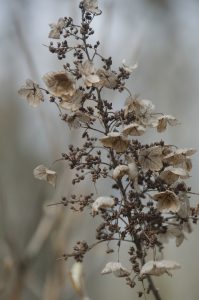
The browned flowers of the oakleaf hydrangea are almost as pretty to me as the flower at it peak of bloom. I never remove the flower stalks. they are just too pretty.
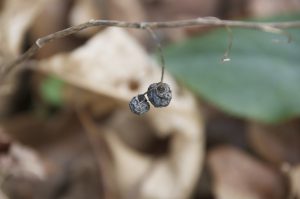
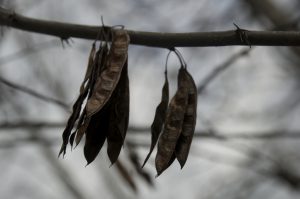 Solomon’s Seal seeds dangle from the stalk, waiting for a critter to eat it and scatter it, or to just fall to the ground and sprout. I just let me alone, as it can take two or three years to grow them inside from seeds.
Solomon’s Seal seeds dangle from the stalk, waiting for a critter to eat it and scatter it, or to just fall to the ground and sprout. I just let me alone, as it can take two or three years to grow them inside from seeds.
Getting in the Holiday Spirit
I love to cook, but don’t do it much anymore with just the two of us here. Scott is not an adventurous eater, so my meals tend to be constant repeats from the week before.
When I get in a cooking mood, somebody’s got to come and eat. Today, my Sunday school friends came over for a soup and dessert lunch. I spent the last two days dicing, slicing, and baking.
On the menu-clam chowder with crumbled bacon and oyster crackers, broccoli cheese soup with crusty French bread, and tomato vegetable soup, made with tomatoes and potatoes from my garden. Of course, veggie soup calls for piping hot cornbread. I wanted to keep with the theme of Fall, so for dessert I had apple dumplings, pecan pie, pumpkin pie, and caramel pecan cheesecake.
I finally got the urge to do a little fall decorating, so the mantle, front porch and table all have taken on a festive air. I’m not much into the frou frou stuff, but I do enjoy holiday decorating.
I found these pretty wheat candlesticks after Thanksgiving last year and just love them. The Pilgrims came from Tuesday Morning, also an after holiday sale. I always stitch out any design I am going to put on napkins or other items on a piece of plain fabric, so as to not make a mess on my finished piece. It helps to see if I like the colors that I chose, but that left me with dozens of what I call ‘stitchouts’. I decided not to waste them, so used a decorative stitch to attach them to a table runner. I think I have enough stitchouts to make a dozen runners! The front porch arrangement is in an old glass jar I used years ago at Christmas, put found a new use for it this year. Just goes to show you should never throw anything away.
I got new dishes and put them to use today. I think the table turned out very pretty. With the placemats and napkins I stitched up, the new bowls really accented the colors I chose for the fall table.
I always have such a great time with my Sunday School buddies, and miss those who weren’t able to come. So now I am plying the internet for Christmas ideas. I just love the holidays.
Become a Butterfly Gardener
Swallowtails on Liatris Silver Spotted Skipper on Phlox
Black Swallowtail on Joe Pye Weed Spicebush Swallowtail on Phlox
Buckeye on Brown Eyed Susan Gulf Fritillary on non native Zinnia
Monarch on a zinnia (monarch Red Admiral hatched from a chrysallis formed in net butterfly hatchery on my porch
I’ve had lots of visitors in the pollinator garden this week.
It seems people are showing more and more interest in attracting butterflies to their gardens. A group of native plant society members recently spent a Saturday in Plains, GA meeting President and Mrs. Carter, enjoying a one woman play, and visiting the Rosalyn Carter Butterfly trail gardens all around the town of Plains. We all have pollinators gardens, and most of our gardens have been registered with the Rosalyn Carter Butterfly Trail.
Now is a great time to be on the lookout for butterflies, as many are migrating. Hope you have lots of blooms in your yards to welcome these delicate visitors. Host plants will help to keep them in your yard as they find places to lay their eggs. Most important right now is the milkweed as the monarchs will soon be on their southern migration back to Mexico. If you don’t have milkweed this year, be sure to get some in your garden by next year. The monarchs look for it on both the northern migration in the spring and the southern migration in the late summer/early fall.
A great book for identifying butterflies, their preferred nectar and host plants, and their habitat range is Butterfly Gardening with Native Plants-How to Attract and Identify Butterflies by Christopher Kline. I especially like it because it gives a time line showing the months you would most likely see the particular butterfly in the Eastern United States. It’s never too late to become a butterfly gardener!
Hope you enjoy a peek at my world of butterflies!
Flittering Through the Garden
I’ve been keeping a close watch on the fennel, hoping to spot some swallowtail caterpillars. Last week, I hit a jackpot, with about 10 cats in different instars. I collected four of varying sizes and put them in my net butterfly tower to observe them as they matured. They ate all day, every day to the point where I was replacing the fennel once or twice a day.
When the first caterpillar got long and fat, I knew the show was about to begin. I took pictures over the next four days, and here is what happened:
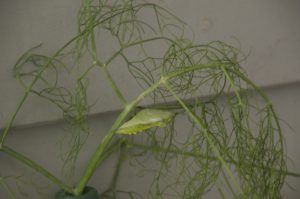
Overnight, the striped caterpillar becomes a green chrysalis. Notice it is on a green twig, so the green chrysalis gives it camouflage.

By the next day, another one has transformed into a perfectly camouflaged chrysalis to hide on this brown twig. Forming a chrysalis the same color as the twig it’s attached to is their form of camouflage to protect themselves from birds and other predators.
I left the cages open on the breezeway so the emerging butterflies can fly away. If left in the closed net house after emerging, they damage their wings trying to find a way out. In one to two weeks I should have some new visitors in my garden.
I’ll move all four chrysalises into one butterfly house and bring in some gulf fritillary cats for the second net house to watch what they’ll do.
Where Has the Time Gone?
Unbelievably, it’s been 4 months since I posted to this blog! My, how time does fly. I’ve been through the spring wildflower season, most of the summer vegetable season, and now the gardens are winding down due to heat and lack of rain. But there are still a number of hardy plants hanging in there for the pollinators to feast upon.
I’ve been moaning and groaning about not having many butterflies this year, when lo and behold they showed up last week! Tiger Swallowtails, both black and yellow, and for the first time ever, Spicebush Swallowtails. The Gulf Fritillaries have laid a bazillion eggs and now the Maypops are covered with caterpillars of all sizes. The Swallowtails have deposited their eggs on the fennel. I brought half of them in and put them in my butterfly hatchery to protect them from the birds. Good thing, too, since all the rest were gone today. And since they weren’t big enough yesterday for me to think that any of them had formed a chrysalis, I’m assuming there are some baby birdies somewhere with a full tummy today. (And did you know that it takes between 5,000 and 6,000 insects for a pair of birds to raise a brood to maturity. My second batch of bluebirds just fledged, along with 10,000-12,000 insects they consumed.)
Once again, my natives seem to be the best lure for the butterflies. They mostly preferred the Liatris, which is also one of my favorites-beautiful fuzzy lavender blooms on a five foot stalk. With so many blooms per stalk, they are bound to be a top choice-lots of food in one place. Kind of like grazing at the buffet. In this picture, a butterfly appears to be reflected in a mirror, but it is actually two butterflies, one with it back to the camera the other with it underside facing the camera.
 Right up there with the Liatris in attracting the butterflies was the Joe Pye Weed. I cringe when I call it ‘weed’, because that name may scare some people off from this beautiful flowering perennial. I have two kinds-one is about 10 feet tall and the other is a dwarf, reaching only about 4 feet tall. Each is topped off by clusters of pink blooms that are butterfly, bee, and moth magnets. In this picture you can see three yellow and one black Tiger Swallowtail enjoying a meal. Bumblebees, sweat bees, honey bees, moths-all kinds of critters rely on this plant.
Right up there with the Liatris in attracting the butterflies was the Joe Pye Weed. I cringe when I call it ‘weed’, because that name may scare some people off from this beautiful flowering perennial. I have two kinds-one is about 10 feet tall and the other is a dwarf, reaching only about 4 feet tall. Each is topped off by clusters of pink blooms that are butterfly, bee, and moth magnets. In this picture you can see three yellow and one black Tiger Swallowtail enjoying a meal. Bumblebees, sweat bees, honey bees, moths-all kinds of critters rely on this plant.
The Phlox cultivar is very attractive to the Tiger and Spicebush Swallowtails. I think this is the ‘Davidii’, but not sure. I didn’t have to wait long to get pictures of the butterflies on the Phlox. I bought a new phlox last week and put it in the ground Saturday, and noticed that the Spicebush butterfly was visiting the few remaining blooms today. I pruned back the old bloom heads, and hope they will put out a new flush of blooms soon.
The pink Phlox, Phlox paniculata ‘Jeana’, is the best performing Phlox in the garden-no signs of powdery mildew, stays upright no matter how tall it gets, and is spreading a a nice rate. The Swallowtails flit between this Phlox and the Liatris across the vegetable garden. They are so accustomed to me being out there, I can get within a few inches and watch them probing with their long proboscis for nectar. I need to get the video camera out there and make a nice video of the butterflies drinking nectar.
I have three kinds of coneflowers in the gardens, Purpurea, which is the species, and two cultivars-Smooth and Tennessee Coneflowers. All are equally attractive when in bloom, but the flowers present quite differently-one kind has flat petals, another petals that curve upward and another with petals that curve backwards. I’m loving some of the new cultivars that I see in bloom in the nurseries right now, but have to have some evidence that they haven’t hybridized the nectar out, making them unattractive to pollinators. When I see pollinators on them in the nursery, I’ll spring for a few of those to add another dimension of color to the beds. Perched her on top of a coneflower is the Spicebush Swallowtail, distinguished from the Black Swallowtail by the absence of orange spots on the upper side of the wings.
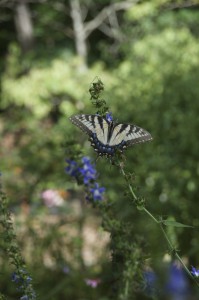 The Tall American Bellflower (Campanulastrum americanum) has surely outdone itself this year. They have been blooming for weeks, with no end in sight. I bought this plant last year at the Native Plant Society sale at Stone Mountain. There was only one, and they didn’t want to bother with making a sign for just one plant so I said “I’ll take it!” And, boy, am I ever glad I did! It’s blue is about the purest blue I have ever seen in the garden and the butterflies, bees, and flying critters love it. Today I saw quite a few bumblebees on it, but some butterflies stopped by for a sip too.
The Tall American Bellflower (Campanulastrum americanum) has surely outdone itself this year. They have been blooming for weeks, with no end in sight. I bought this plant last year at the Native Plant Society sale at Stone Mountain. There was only one, and they didn’t want to bother with making a sign for just one plant so I said “I’ll take it!” And, boy, am I ever glad I did! It’s blue is about the purest blue I have ever seen in the garden and the butterflies, bees, and flying critters love it. Today I saw quite a few bumblebees on it, but some butterflies stopped by for a sip too.
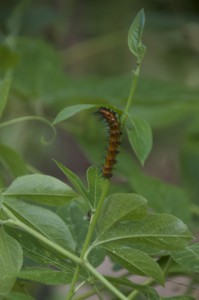
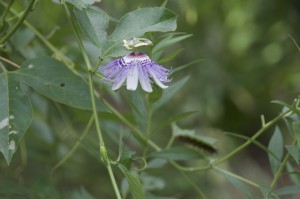 I didn’t see any Gulf Fritillaries today, but they left their calling cards. Dozens of orangish caterpillars in all stages of development on the Maypops are soon going to start forming chrysalises assuring me of the continuation of these beautiful orange butterflies in my garden. The Maypops have been a little lazy blooming this year, probably due to the drought, and I’ve been a lot lazy in removing the strays that come up all over the garden. Glad now I left those strays, because they are hosting many caterpillars. Unfortunately, the birds are also chowing down on these caterpillars, but I think enough will survive to provide butterflies for the garden. I put two pictures here, one to show a large fritillary cat to make them easy for others to recognize, and the other is the bloom of the Maypop with a caterpillar in the background.
I didn’t see any Gulf Fritillaries today, but they left their calling cards. Dozens of orangish caterpillars in all stages of development on the Maypops are soon going to start forming chrysalises assuring me of the continuation of these beautiful orange butterflies in my garden. The Maypops have been a little lazy blooming this year, probably due to the drought, and I’ve been a lot lazy in removing the strays that come up all over the garden. Glad now I left those strays, because they are hosting many caterpillars. Unfortunately, the birds are also chowing down on these caterpillars, but I think enough will survive to provide butterflies for the garden. I put two pictures here, one to show a large fritillary cat to make them easy for others to recognize, and the other is the bloom of the Maypop with a caterpillar in the background.
By next week, the six foot tall Boneset and the 12 foot tall Ironweed should be in full bloom, assuring the pollinators of a new smorgasbord to delight. Everyday in the garden brings new delights, and I am always anxious to get out there and see what new plant is blooming, what new insect is in the garden, and what new veggie is ready to be picked.
Native plants in the landscape really draw in the pollinators. Many of them will take nectar from both native and nonnative plants, but for many of them, there is a single type of plant that can host the caterpillar. If you love Gulf Fritillaries, you’ll have to plant Maypop. For Spicebush Swallowtails, you need a spicebush (duh). The Monarchs will be migrating soon, and I’ve made sure to have plenty of milkweed planted just for them. That’s the only host plant on which they will lay their eggs. The Pipevine Swallowtail hosts on the Pipevine, Aristolochia. I don’t have any cats on the pipevine yet, but there’s always hope. It’s fairly recently planted. Maybe next year!
Natives plants are a consuming passion for me. I have planted hundreds of natives in the yard-serviceberry, grancy graybeard, Yellowwood, viburnum, stewartia, dogwoods, hollies, red and white buckeyes, hawthorns, oakleaf hydrangeas, sourwood, pawpaw, and beautyberry. These trees and shrubs will provide nectar for insects and hummingbirds from spring til mid summer. Then they will provide berries and seeds for the birds and other wildlife during the fall.
I plant all kinds of native flowering plants. Some are just too pretty to live without, even if they are critical for the pollinators. These are usually finished blooming long before the pollinators are active. Some of my favorites, other than those mentioned above are Cardinal flower, Wild Bee Balm, Tickseed Coreopsis, New England Aster, Georgia Asters, Clethra, Flat topped Aster, Native Coral Honeysuckle, Trumpet creeper vine, Thimbleweed, and penstemon. There are tons of others, but a longer list would become tiresome for readers. Please check out the GNPS webpage and facebook page. The web address is www.gnps.org. The West Georgia Chapter also has a facebook page and a web page at wgawildflowers.org. You’ll find interesting articles, upcoming events and plant sales, as well as pictures of wildflowers.
If you can wade through the advertising, you’ll find this page helpful in deciding what to plant for the particular butterflies you want to host. There are links on the page with lists of host plants, butterflies in your geographical area, and many other fun things to know about butterflies.
http://www.butterfly–garden.com/
But don’t forget that there are many more efficient pollinators than butterflies, and they are quite pretty themselves, if you like bugs!
Do, Do, Do Lookin’ Out My Backdoor…..
Spring has come, and practically gone with these warmer temps. We’ve been sleeping with the attic fan pulling in the cool breezes, listening to the barred owls making whoppee outside our bedroom window. The butterflies are back-saw a couple of swallowtails today. I also found a luna moth sitting on an Iris leaf. Even my digging and planting beside it didn’t seem to disturb it, and when I turned on a sprinkle to water in the new plants, he/she just sat there. (From the appearance of the antennae, I believe it’s a he.) The female will soon lay 400-600 eggs on the leaves of the hickory, sweet gum and persimmon trees. That’s another reason it’s important to keep those native trees in your yards. As I strolled around the yard this week, here’s what I saw. Most of my spring lovelies are on the downhill side, the late spring bloomers are looking good.
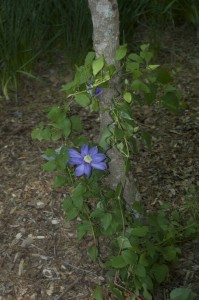
I’ve planted vines of various kinds at the base of lots of my trees-blooms even if the tree isn’t blooming
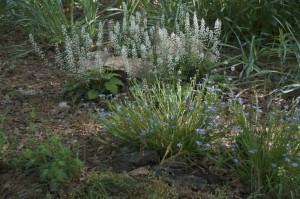
This is one of the newest plantings-the native tiarella and native Blue Eyed Grass. They have been blooming for about three to four weeks.
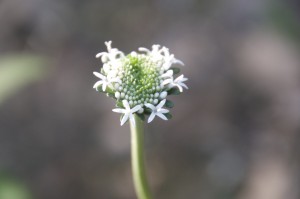
The Barbara’s Buttons are just beginning to flower out. They are great for pollinators like butterflies and beetles.
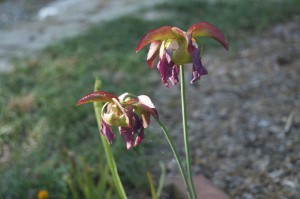
My first attempt at a bog garden has proven quite successful. These Sarracenia, or Pitcher Plants are blooming and the pitchers are beginning to spring up.
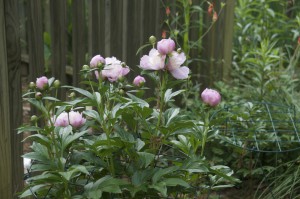
The peonies let you know they are around with their wonderful smell. I guess the ants can smell them too, as they won’t be long in feasting on the blooms.
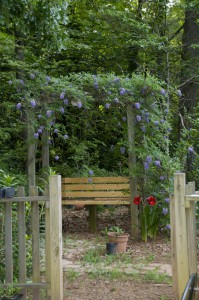
The arbor is sporting the beautiful Amethyst Falls wisteria, one of our native wisterias. It doesn’t stray from it own space. I’ve had this one for about 8 years and never had to remove a sucker or runner. If you love wisteria, opt for the native instead of the Japanese or Chinese wisterias that you see climbing over cars, fences, buildings, and anything else that gets in its way.
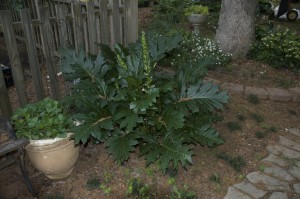
Although it’s not native, I love the Bear’s Britches. In a couple of weeks it will have a six foot tall bloom stalk with flowers that look like little purple clam shells.

The new trough I built for my strawberries must be a good thing, because the birds have left a few for me.
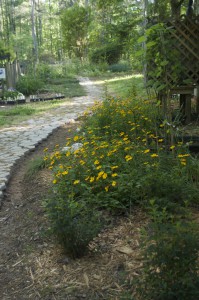
The back side of the garage has been filled with the pretty yellow mouse-eared coreopsis for weeks, and they’ll continue to bloom for several more weeks. By then the mountain mint, smooth coneflowers, zizia and a few others will take their place.

Penstemon, or Beardtongue, are a must have flower for early pollinators. Their tubular shape is ideal for many of the pollinators.
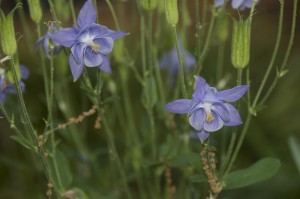
I have a bed of non native columbine that I adore, so that’s one bed that I will not be replacing with natives. There are light purple, dark purple, purple/white mixes, pink, corals, whites and yellows.
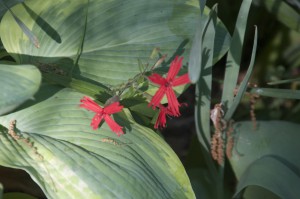
I finally got my hands on some fire pink. After seeing these all over the hillsides in the Smokies at last year’s pilgrimage, I have been on the prowl for some for my garden. They are peeking from underneath some huge hosta leaves.
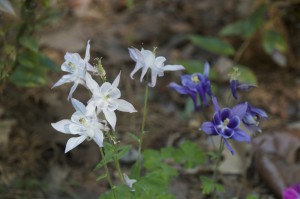
I have no idea how these columbines came to be in my yard. They are no where near the others. Just a lucky accident I guess.
.
A Walk on the Wild Side
My friend Dorothy and I just returned from four days in Gatlinburg for our second experience at the Wildflower Pilgrimage. With two hikes a day, one before lunch and one in the afternoon, we were able to walk with botanists, college professors, professional photographers, ecologists, and many experienced wild flower enthusiasts. As we walked, our guides pointed out specific plants and gave us some information about them. We saw trilliums of all kinds, Bishop’s Cap, tiarella, Solomon’s Plume, Solomon’s Seal, pink and yellow Lady’s Slippers, and countless others. We walked a couple of miles at over 5000 feet elevation along the Appalachian Trail. On the Chestnut Top Trail we walked along a steep ridge just wide enough for single file hikers. As we waded streams, climbed over large fallen logs and huge boulders, we were overwhelmed with the beauty of the mountains. We prowled around the forest at night hoping to catch a glance at owls as they flew overhead. Nothing can prepare you for the beautiful sights along the trails, the cascading waters of the many streams in the Blue Ridge Mountains, the waterfalls, and the pure joy of taking a ‘forest bath’ each day.
I’ve been gardening most of my life, and have never enjoyed the world of plants with as much enthusiasm as I have for these natives. I am slowly removing my non native trees, shrubs and flowers and replacing them with natives- more useable nectar for the pollinators, more digestible leaves for our many insects, which in turn provide more food for our birds and their babies. And once established, native plants require very little human intervention-after all, nobody goes into the woods to water and fertilize the native plants there. As a result of my changing my gardening focus, I’ve seen an increase in the number and variety of birds in the yard, as well as a greater influx of pollinators, especially the native bees which are the most efficient pollinators of all our insects.
It’s hard to believe that I’ve learned so much about these plants in less than 6 years. Much of that knowledge comes from attending rescues of native plants that are in danger of being destroyed by development. Walking through the woods with experienced native plant people is the best education you can get! If you want to learn more about how to identify native plants, why they are so important, and how you can help save them, get connected with the native plant society near you.
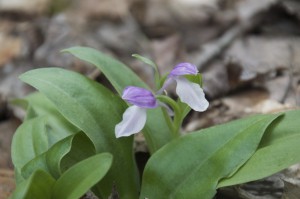
The showy orchid, Galearis spectabilis, is such a lovely native plant and seems to be quite common on several of the hiking trails.
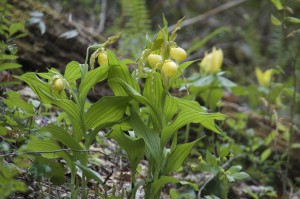
Yellow Lady’s Slippers are a joy to see. They sit perched high on the hillsides, just begging to be noticed.
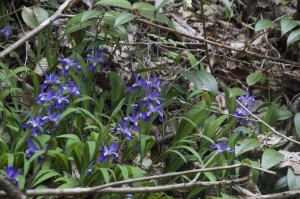
This Dwarf Crested Iris, Iris cristata, is the darkest purple I’ve ever seen on the little beauties.
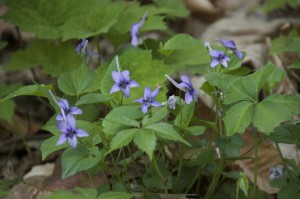
There must have been a dozen different kinds of violets on the trails, but I think this was probably the most prevalent-the long spurred violet-Viola rostrata.
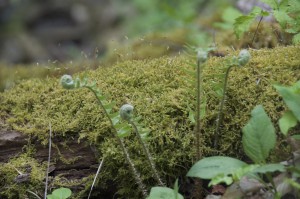
We took one hike that focused solely on native ferns. Of the nineteen kinds found in the Smokies, we saw 16, with lots of information to help us distinguish between the different ferns. These are the fiddleheads of the native Christmas fern. I understand that some fiddleheads are served boiled, broiled, baked, or batter-fried and are quite tasty. Don’t think I’d sacrifice any of my fiddle heads for that though.
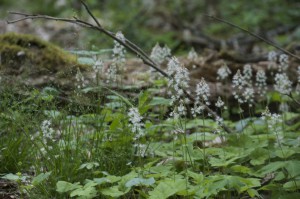
Tiarella cardifolia, or foamflower, is one of the most common flowers in bloom on the trails right now. This is one of my favorite natives-long bloom time, easily adapts to many habitats, and just darn pretty.
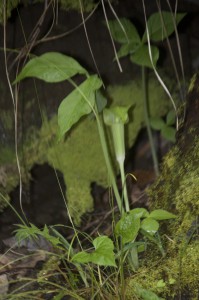
Everyone always gets excited when they spot a Jack in the Pulpit in bloom. The Arisaema triphyllum is a beautiful little plant.
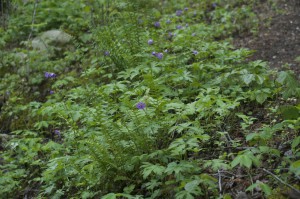
This mixture of ferns, Phacelia and Mayapples was just one of many combinations that Mother Nature designed.
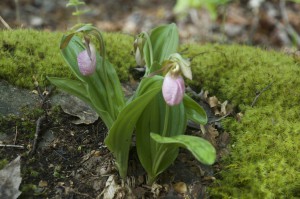
This pretty little pink Lady’s Slipper was growing in a crevice of a large rock. I found out later that the indention was made when someone tried to steal the orchid, but left enough roots behind for it to regenerate and regrow. What a shame there are such selfish people who can’t take a picture and leave the plants for others to enjoy.
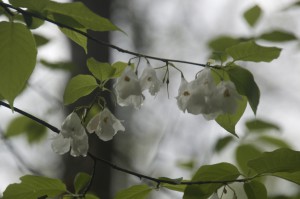
The lovely Silverbells, Halesia tetraptera; formerly H. carolina, was blooming along the roadsides almost to the point of being invasive. But I say, ‘Hey let a few invade my yard.’ (which they did last year following a rescue in Sand Hill)
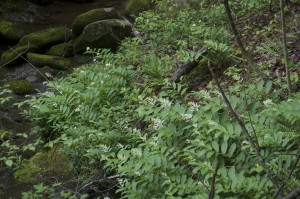
Solomon’s Plume, sometimes called False Solomon’s Seal, cascades down the steep hillsides from the trail to the stream far below. One of the most striking of our natives that blooms in spring, it is pretty even when not in bloom.
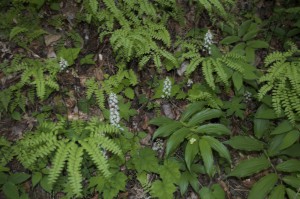
This Maidenhair Fern is the perfect compliment to the Tiarella and the Solomon’s Plume. White it looks very delicate, the Maidenhair is actually very hearty.
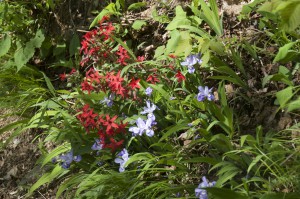
I have coveted the Fire Pinks since my Pilgrimage last year, and finally found some for sale at a recent plant sale. It will be a while before mine look like this, but I’m patient. Growing here with the pretty little crested Iris, it is a standout.
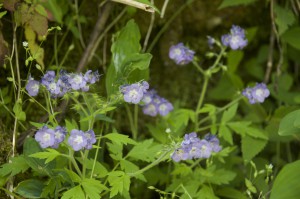
Hillsides were covered with this pretty Phacelia, or Scorpionweed as it is commonly known. If you can’t make it to the Smokies for the Pilgrimage, make a trip to the Pocket up in extreme Northwest Georgia in spring and you’ll be blown away by the abundance and beauty of t his plant. One of these found its way into my garden last year.
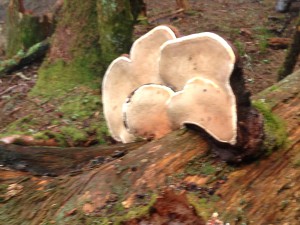
Fallen trees remain on the forest floor to rot away and provide nutrients for the living trees. Lichens and mosses love these dead trees. This lichen was on a fallen hemlock along the Appalachian Trail near Indian Gap.

Dorothy and I can now claim to be hikers of the Appalachian Trail, even if it was only a couple of miles!
WATCH FOR POSTS ABOUT THE 2017 PILGRIMAGE ON THE WEB PAGE OF THE WEST GEORGIA CHAPTER OF THE GNPS. REGISTRATION IS IN MARCH WITH THE PILGRIMAGE IN APRIL. IT’S AN EXPERIENCE YOU’LL NEVER FORGET.
My Little Piece of the World
So, what’s going on in your little piece of the world? My little piece of the world has been a hotbed of activity. I have been removing striped liriope and replacing it with a beautiful evergreen sedge that will have pretty stalks of yellow and chocolate brown blooms this spring. The liriope has next to no value to our native wildlife, so it had to go. I have several buckets full of the liriope that needs a new home if anyone is interested.
On Tuesday, I raked and mulched leaves from a bed of iris and daylilies. These, too, have little wildlife value, so they are going to new homes also (or to my compost bin). I am replacing these with ferns and another native sedge that has a great clumping habit and beautiful red tinged blades. Can’t guarantee the colors, but the iris and daylilies are ready for new homes.
For Christmas, Brandi gave me some lovely black metal raised bed corners. I have enjoyed my raised beds edged with pavers, but they are very aggravating when they tumble apart every time I drag the hose through the garden. So I bought 2X10 lumber and am using the metal corners to rebuild all the beds. They are somewhat deeper than the old brick beds, so I’m filling in the top 4 inches with compost, goat and chicken manure, and good topsoil. I’ve finished 3 of the 6 beds I plan to do, and have garlic growing in two of them. Next week, I’ll add potatoes to these beds, along with some bunching onions which I’ll plant from seed. One of the beds will be planted with sugar snap peas. I love those things! I sometimes go to the garden and pick them and eat them raw right there on the spot. Since I don’t use any kind of pesticides or herbicides, I don’t worry about eating them in the garden.
My big concern about the new beds was the expense and aggravation of getting enough good ‘stuff’ to finish filling them. My neighbor, Frank, came through with an offer of goat manure and chicken litter from a friend who has a mini farm in Tallapoosa. We went yesterday and got two truckloads, but it was a time consuming activity since we spent almost 2 hours trying to get his truck out of the back yard where it had gotten stuck and couldn’t pull up the hill on the soggy ground and leaves. I think we loaded both our trucks in less time that it took to rescue his truck. Lesson learned: put the manure in buckets and haul it to the trucks in the nice graveled driveway!
I have spent a part of several days this past week pruning back the old leaves from the hellebores. This wet winter has caused a lot of black fungus, which needs to be removed to avoid the whole plant being infested and rotting. Although the hellebores are not native, I keep them for two reasons-blooms during January and February for arrangements for church, and my honeybees love them!
I’ve started seeds in the basement under grow lights over the last week or so. Have lettuce and spinach up and growing, but no signs of the cabbage or rutabagas yet.
The native plant society is working with a school group who has a field trip planned. We’ll be talking to the kids about the importance of protecting our native plants for the wildlife and for our own enjoyment. Then, they’ll each have a native flower to take home and plant in their own yards. We have planted several hundred at the UWG greenhouse where they are being tended by the dedicated staff of the grounds department. I’ve also started a whole flat of orange butterfly and pink milkweeds for the monarchs. These will be added to the ones we have growing at the college. And some of them will be potted for a plant sale at our meetings. I already have about a hundred red cardinal flowers in gallon pots just waiting to be bought and taken to a new home.
My back yard is still filled with trees and shrubs donated by the Georgia Wildlife Federation for planting on the Buffalo Creek Trail. We’ll begin on that at our next workday, Feb. 17. If you want to come help, we would welcome you. We’ll be there planting from 10-12 that day and again on Feb. 27th. Mostly we’ll be working on the back entrance which will connect the BCT with the Greenbelt. We’ll also be planting some donated cedar trees behind the storage buildings, to screen the buildings from the trail. Some of the donated trees will be passed on to a Clayton County group that is working on a trail down there.
This warm weather has tricked some of my flowers into thinking it is early spring. I have muscari and crocus in bloom along with daffodils. The hellebores have been blooming for about a month now. The daphne growing by the deck is in full bloom and the backyard smells like fresh lemons or Lemon Pledge. In the side yard the beautiful yellow blooms of the native green and gold have started peeking out. In the front yard there is edgeworthia is in full bloom. The smell is something I can’t put my finger on, but if I could bottle it, I’d make a million dollars. The sweet scented ‘Fragrant Bouquet’ viburnum is in full bloom along with the winter honeysuckle. It has a sweet smell you can catch all over the front yard. Scott’s camellias are beginning to open their buds and they are quite pretty. I noticed today that my native ladies’ tresses orchids have started popping up, and it looks like there may be quite a few babies.
Next week Frank and I are leading a rescue at a site where we’ll be able to get lots of ferns, and hopefully some bloodroot, one of my favorite early blooming natives. We’ll also be on the lookout for some parsley hawthorn, some vernal iris, and maidenhair ferns. This will be our first rescue of the new year, since our first attempt got rained out. Can’t wait to get back into the woods again.
Even though it’s winter, there are still lovely things to see in the garden. Get out there and take a peek, or a sniff, or cut a bouquet. Doesn’t matter what you do, but make time for your ‘forest bath’ to get renewed.


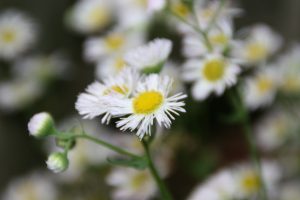
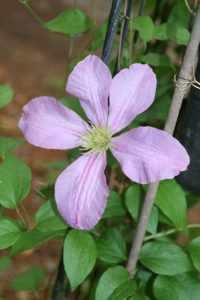
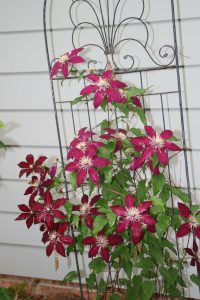
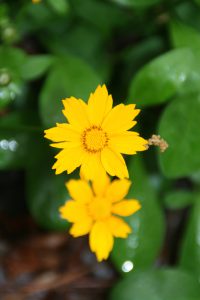
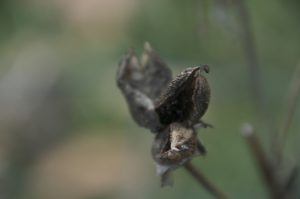
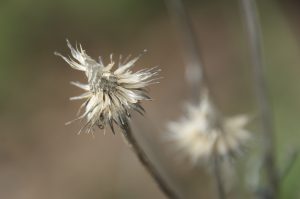
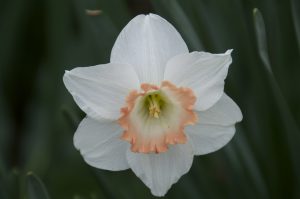
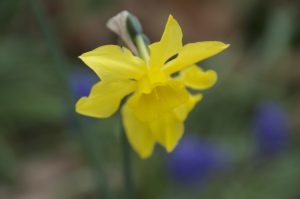
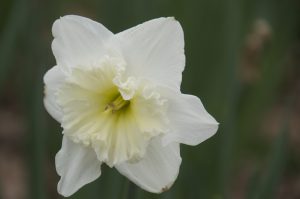
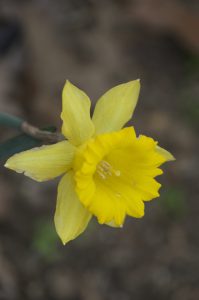
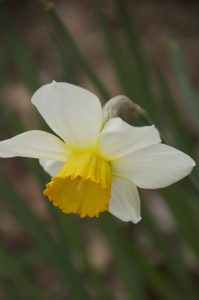
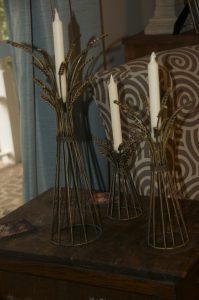
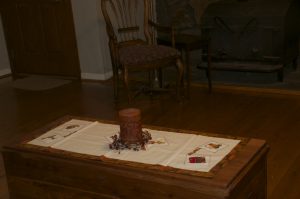
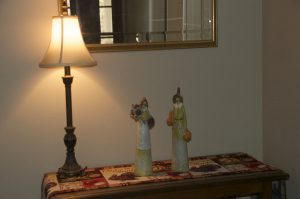


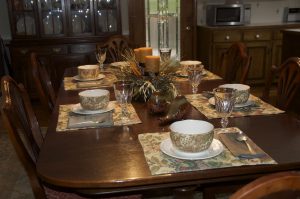
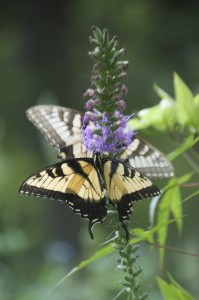
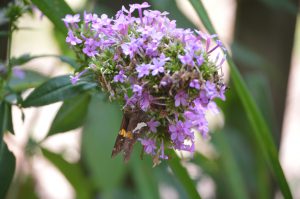
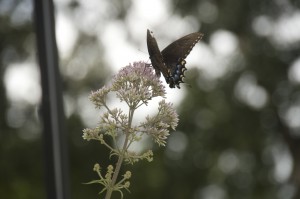 l
l